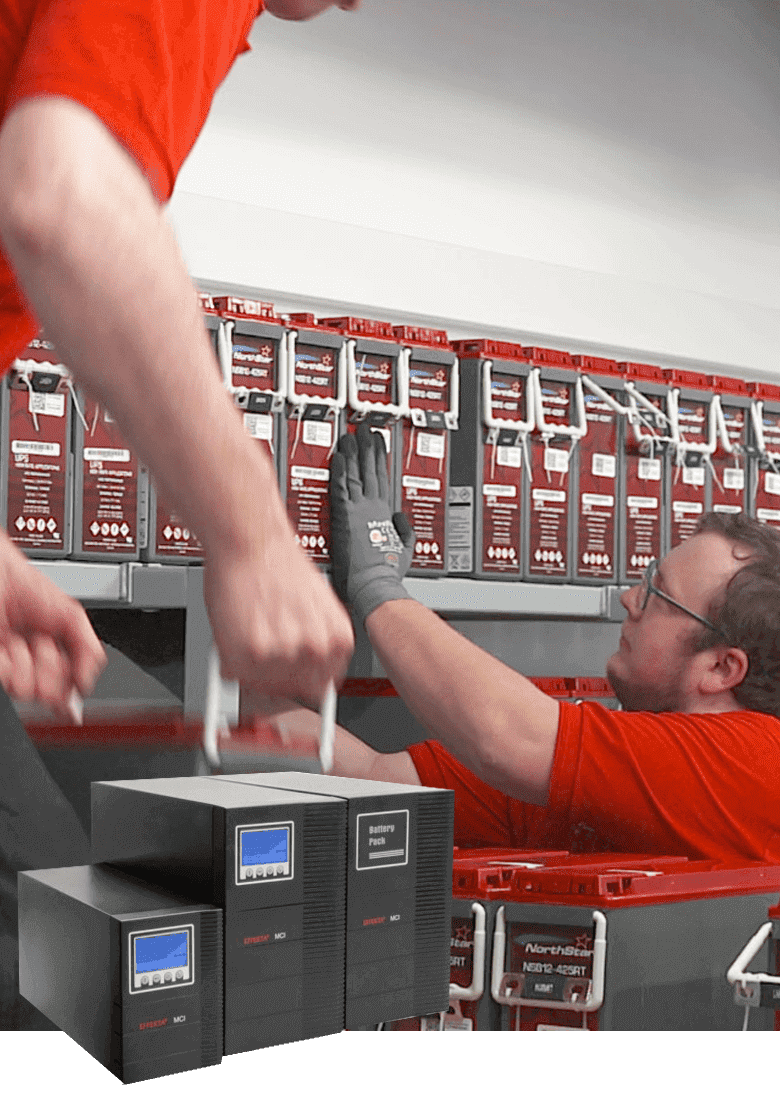Uninterruptible power supply
Power failures are not uncommon and can lead to data loss or life-threatening situations. UPS systems are ideal for protecting against this risk.
Get price benefits now as a B2B customer!
Register today and take advantage of our wide selection of products including competitive prices!

UPS systems are essentially divided into three categories:
Offline / standby UPS systems of classification 3 according to IEC 62040-3
Provide protection against power failure, voltage drop and overvoltage. This type of UPS system offers the least protection, but at the same time is usually the most cost-effective variant. It is referred to as an offline or standby system because the system only takes over the supply of the connected loads in the event of a power failure. Due to the switching time, voltage dips of up to 10 ms often occur. Often, IT consumers such as computers can compensate for this delay, so that no mains failure is noticeable at the consumer. These types of systems are therefore almost exclusively intended for computers or small IT devices that are not mission-critical consumers.
Line-interactive UPS systems of classification 2 according to IEC 62040-3
Offer additional protection against short circuits in the public network and line noise. The line-interactive system is considered an intermediate stage between offline and online technology. In contrast to the offline UPS system, systems of this classification also smooth the output voltage so that they also protect the connected loads against voltage peaks and line noise. These types of systems are also suitable for protecting computers and partly also for server systems that are not mission-critical consumers.
Online UPS systems of classification 1 according to IEC 62040-3
Provide additional protection against high voltage spikes, frequency deviations, switching peaks and harmonic harmonics. UPS systems of the online classification provide optimum protection for your loads and can be used for business-critical applications. Due to the double conversion technology, there is no voltage interruption in the event of a mains failure and the loads are permanently supplied. In addition, systems of this category also protect against various types of voltage disturbances. Since the rectifier and inverter of the UPS system are permanently in operation, a pure sine wave is generated so that an optimal voltage supply is permanently provided for your consumers.
FREQUENTLY ASKED QUESTIONS
You have questions about the UPS systems?
Here you will find a summary of the general questions and answers on the subject of UPS systems.
If we have not answered your questions, please contact us by e-mail or telephone.
We will be happy to help you. info@akkusys.de+494101 37676-0
1
What is a UPS system?
An uninterruptible power supply system (UPS for short) is used to provide emergency power to connected loads in the event of a power failure.
2
What types of UPS systems are there and what type do I need?
UPS systems are essentially divided into three categories:
Offline / standby UPS systems of classification 3 according to IEC 62040-3: Offer protection against power failure, voltage dip and overvoltage. This type of UPS system offers the least protection, but at the same time represents the most cost-effective variant. It is called an offline or standby system because the system only takes over the supply of the connected loads in the event of a power failure.
Due to the switching time, voltage dips of up to 10 ms often occur. Often, IT consumers, such as computers, can compensate for this delay so that no mains failure is noticeable at the consumer.
These system types are therefore almost exclusively intended for computers or small EDP devices that do not represent mission-critical consumers.
Line-interactive UPS systems of classification 2 according to IEC 62040-3: Offer additional protection against short circuits in the public network and line noise.
The Line-Interactive system is considered an intermediate stage between offline and online technology. In contrast to offline UPS systems, systems of this classification also smooth the output voltage so that they also protect the connected loads against voltage peaks and line noise.
These types of systems are also suitable for the protection of computers and partly also for server systems, which do not represent mission-critical consumers.
Online UPS systems of classification 1 according to IEC 62040-3: Offer additional protection against high voltage peaks, frequency deviations, switching peaks and harmonic harmonics. UPS systems of the online classification provide optimum protection for your loads and can be used for business-critical applications. Due to the double conversion technology, there is no voltage interruption in the event of a mains failure and the loads are permanently supplied.
In addition, systems of this category also protect against various types of voltage disturbances. Since the rectifier and inverter of the UPS system are permanently in operation, a pure sine wave is generated so that an optimal voltage supply is permanently provided for your consumers.
3
What UPS power do I need?
The required UPS power is directly dependent on the connected loads and their load profile.
In order to correctly dimension the UPS system, the following information is required on the connected loads:
Power
Cosphi
Inrush current (overload behaviour)
Based on a corresponding load table, the maximum load current as well as the maximum inrush current can be calculated, which serves as the basis for UPS dimensioning.
We recommend a maximum load of approx. 60% for all UPS systems in order to take growth and power reserves into account.
4
How long is the bridging time of the UPS system?
The bridging time is directly dependent on the connected load and the installed battery system.
The battery system for the UPS systems can vary from 1 kVA upwards, so this cannot be answered in a general way.
5
How big is the battery system?
Depending on the connected load and the desired bridging time, battery systems can vary. Optimally, internal batteries installed in the housing of the UPS system are sufficient. In this case, the space requirement is minimal. However, with increasing requirements in terms of bridging time and load, it is often necessary to switch to external batteries that have to be installed on a separate rack or in a separate battery cabinet.
6
Can I monitor the UPS system?
The majority of the UPS systems can be equipped with additional network cards or fault messages so that monitoring can be carried out via SNMP or a connection to the BMS.
However, these monitoring devices are often not installed as standard in the UPS system.
7
How much space do I need for a UPS system?
This also depends on the load to be supplied, as well as the desired / required bridging time.
Depending on the load to be supplied, standard-related requirements may also play a role.
In principle, however, every UPS system should be freely accessible and there must be sufficient wall clearance for ventilation.
This also depends on the performance of the UPS system.
Battery systems in particular are subject to technical standards requirements due to the gases they emit during heavy charging.
8
How long is the service life of the UPS and battery system?
For battery systems, a distinction is usually made between 5, 10 and 12-year batteries. However, these are service life expectations under optimal conditions.
Experience shows that often only 70-80% of this service life expectation is achieved.
For UPS systems, regular maintenance is crucial for the service life maintenance of the system. With regular maintenance and the regular replacement of the necessary wearing parts, UPS systems can achieve a service life of 15 years.
9
Is maintenance required for UPS system?
According to DGUV V3, the operator's responsibility places the operator of emergency power systems under the obligation to carry out regular maintenance on electrical systems. Proper maintenance should be understood as an investment in the future. No operator of an emergency power system wants a system that does not take over in situations of power failure. Therefore, maintenance work makes sense in order to be able to ensure the reliability and availability of your consumers even in the event of a power failure. We recommend a maintenance interval of one year, this is also required in VDE 0105 for electrical systems and electrical equipment.
10
What are the advantages/benefits of a UPS system?
There are several advantages for the user or operator when using UPS systems to protect the connected consumers.
The first and most important advantage is the protection of the power supply of, for example, server landscapes, sensitive measurement electronics and any kind of IT as well as, for example, cash register systems. In the event of a power failure, not only is the loss of data, measurement results or the defect of complex systems prevented, but it is even possible to continue working in the event of a power failure without interruption of the supply by the UPS system.
The second advantage can also be, for example, to bring the "electrical imbalance" of the house connection and the main building distribution back into a symmetrical utilisation of the three outer conductors (L1,L2,L3) through the UPS system.




